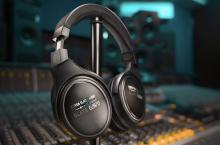Slate Digital VBC (Virtual Buss Compressors) by Diogo C

Disclaimer: I don’t think we need an introduction here as the Slate Digital Virtual Bus Compressors plugins have been extensively debated and we already over 130 thread pages on the subject (here is the active thread), so I’ll cut straight to the point!
The Units
For those who are still unsure about what’s on the table here, let’s recap one more time the units that inspired Slate Digital’s offering:
- VBC Grey: Solid State Logic Bus Compressor
- VBC Red: Focusrite RED Compressor
- VBC MU: Fairchild-670 and others Variable-MU Compressors
- VBC Rack: All three compressors in a single plugin
The Sound
The short story here is:
- Grey: grabby and precise compression with a low frequency treat
- RED: subtle tone and smooth compression
- MU: characterful tone and mellow compression
One of the best way to use the VBC is to begin a session mixing “into” the unit right from the beginning. If you want to make bus compression a really meaningful operation in the mixing process, the VBC can be a very rewarding tool. Setup that a vocal bus with the MU, the usual SSL/Grey drum bus and guitars, synth and other harmonic parts through the Red. Grey on a parallel bus to enforce and thicken the rhythm. The whole mix going through the Red or the Grey is also something worth trying out. Setting up multiple buses might get you there faster in terms of achieving a more powerful mix, more easily and more effortlessly, because some of the color you might want to put in your tracks is already there with the VBC.
One thing that needs to be mentioned is the fact that there’s a “volume bump” on all three units when you insert them, and it’s a bit drastic with the Grey. The “bump” is not plain “volume”. but the frequency response of each unit being printed to the signal – an EQ curve instantly applied up inserting the plug-in and (as most of you suspect) it does raise the level along with it. The RED is the most gentle of the pack and it just adds a little top end that marginally brightens things up. GREY has low end beef which is there because of a transformer modification present in the unit modeled by Slate, which is gentle but not that subtle when you compare to the other SSL clones out there. The MU a nice bump with almost +2db around 1-10 kHz, hence the subtle presence this unit instantly applies. Check out the attachments if you're interested in these curves.
The Content
As far as bus compressors goes, these are nicely featured. The original units have been enhanced with side-chain filter (HPF) and mix control for dry signal blending and the Grey has also enhanced the SSL’s original ratios. Slate has also thrown in some plugin goodies such as A/B settings and a preset system. All-around these are certainly lovely features and cover what you expect from a bus compressor and extend their use substantially. One nice feature is the rack version of the plugin, stacking all three compressors within the same interface so you can have a bunch of character and unique blending of the units. However, the lack of mono units and a noise bypass are downsides that Slate promised to address, but one might also argue for authenticity here – their analog counterparts are stereo and have noise. Word of caution is to watch out here, as it can get out of hand and the MU’s in/out knobs are especially sensitive to this issue.
The virtual ergonomics and workflow aspects these units are also quite nice and what you would expect from a plugin of this caliber. The knobs are very precise and can be fine tuned with keyboard controls, the interfaces are fine to read and visualize what’s happening in the in/out and gain reduction levels and overall they’re very easy to work with. Slate could have easily thrown some other treats made possible in feature-wonderland of plugins, such as more options for the side-chain filters, stereo link controls, mid-side (only present in the MU) and extended metering, but they're sticking to the basics and going for the most important feature of all: the sound, and it’s got plenty of that...times three.
The verdict - and some perspective
Slate has done a remarkable job and their Virtual Bus Compressors lived up to the expectations build around it. This is definitely a milestone in plugin technology and the team led by Fabrice Gabriel backed up the big claims with impressive results. I won’t dwell into the hardware x plugin debate, so I’ll just say these are great sounding compressors - regardless if they’re digital or analog.
We all know that the “analog X digital” debate hasn't lost any steam and it doesn't seem like it ever will, but there’s a growing consensus around the fact that things are getting close - very close to the point that even the most educated and experienced ears will sometimes fail to perceive the differences. If people are still doing ABXs and double-blinds and all other forms of testing it means that the differences are now more subtle than ever - Slate Digital might even say they closed that gap, throwing gasoline in the fire and the debate might be now more fueled than ever. Does that means that plugins have won and you should go out now sell your hardware? Absolutely no, for a good number of reasons that don’t belong in this review and we don’t need to remind everyone how good analog is: the sound and workflow associated with analog has been proven over decades to be consistently great at achieving superb sonic results. No software will ever kill that, but they bring their own goods to the table as everyone already knows - and software can also be great sounding as the VBC and many others pieces of code can prove.
On a closing note, I’d like to put what the VBC means into perspective - the perspective of the contemporary producers and mixers. Many of us aren't exactly working under conditions where a two-thousand dollars (or more) bus compressor is readily available, let alone three specially-tweaked versions of those things. For these guys the VBC means having superb sounding compressors for two hundred bucks. It’s dead simple. For perspective’s sake I’ll remind everyone that it’s not only the VBC as there are many plugins out there that are able to deliver a remarkable sound for a very little money. There’s no excuse to sound bad.
Score: 9.2/10
- Sound Quality - 10/10: Gorgeous sounding compressors. Easily among the best plugins created until this day.
- Features - 9/10: For bus compressors they’re very nicely featured, but they don’t take full advantage of the possibilities that the virtual land has to offer.
- Ease of use - 9/10: Very nice interfaces, but the noise (especially on the MU) might get out of hand if you’re not very careful.
- Compatibility and stability - 9/10: Very stable and surprisingly light on the CPU, but updates could be released in a more timely manner. AAX took a bit long to arrive, but Slate kept in touch with the community so users weren’t left in the dark.
- Documentation and support - 8/10: Good documentation with some background history and useful tips. Their support is also OK, a bit slow on ticket response so it might be faster if you go through Gearslutz.
- Bang for buck - 10/10: Besides superb bus compressors, they’re also great all-around track compressors and can be used on many situations.
- Magnificent sounding and relatively versatile.
- Very easy to use and hard to sound bad.
- Light on system resources.
- No mono versions and noise can’t be turned off. Even though it’s part of the modelling, in 2014 it needs to be a choice.*
- Side-chain filter only goes up to 150 Hz (Red/Grey) and 200 Hz (MU).
- The character and attitude might be too much for some, even with the mix knob.
*Promised by Slate Audio to be introduced in a feature update.














